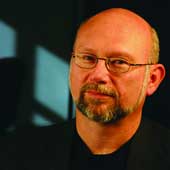Future looks bright for supercomputers

A conversation with Stan Ahalt, executive director of the Ohio Supercomputer Center.
The gap is closing between supercomputing and mainstream computing. The consequence will be more powerful planning and decision-making tools for everyday users and new applications that will tap the vast potential of parallel computing.That's the belief of Stan Ahalt, executive director of the Ohio Supercomputer Center. He is co-chairman of the Ohio Broadband Council, which was launched in July. Gov. Ted Strickland wants agency offices across Ohio to connect via a broadband network. Part of the strategy is to bring supercomputing power to more users.Ahalt recently spoke with Editor Nick Wakeman about the promise and potential of high-performance computing. Supercomputers are very esoteric. They are difficult to program. They are difficult to feed and water ? you have to power them and cool them ? and they are difficult to manage.There is a chasm between what is done on the desktop [PCs] and what is being done by these supercomputers.The downside from a competitiveness and efficiency standpoint is that many [information technology] developers aren't developing big systems by simulation. Instead, they build them by experiment. But if they had a supercomputer at their disposal, they could simulate some of the processes they are building and get a better idea [of how to build] the system they need to put in place.The democratization is the closing of that gap between the supercomputer and the desktop. Absolutely. People are beginning to awaken to the fact that you can use the computer as if it were a laboratory. You can do experiments on the computer that will help guide your thinking.We already are seeing tangible democratization of the desktop because we are getting multiple cores in our laptops and our desktops. We are marching toward parallel computing on our desktop. People are asking how do you make your day-to-day applications run faster by using many cores?You have to learn how to break up problems so [applications] run faster on more processors. That is why democratization has two ends ? the grass-roots impacting the cutting edge. The cutting edge will benefit when the masses start thinking about parallel processing. We have a broadband network for higher education to access the supercomputer system and to communicate with all the universities in the state. We've already added K-12 and now we are going to bring on the state executive agencies.We'll have more people sharing a common IT infrastructure and being able to use advanced computational power to analyze their processes. Slowly but surely, we are starting to change from the ground up what we can do from an IT perspective in terms of cost and where we can get economies of scale.But it is also an organizational issue. When people start to share a common set of technologies they start talking to one another and understanding common objectives. You start to see a network emerge that is a network of people and concepts. One of the drivers is that people are actively thinking about innovation in all sectors, from service delivery to manufacturing.One of the reasons the U.S. economy flourished is that we deployed desktop computing very rapidly. We rode the edge of a technological bubble. Now everyone in the world has that advantage.Broadband access is an important part of this. We have the tools, [and] we can move data around in a reasonably rapid way.If we can push supercomputing down into things like the supply chain, it can differentiate the United States from the rest of the world. We are the world leader in supercomputers, and we have the infrastructure to support it. Remember how frightening it was for some people to get on a computer and check their e-mail? Now everyone does it. It has gotten simpler and we aren't afraid. But we've gotten more skills as well.The same thing has to happen in the supercomputer world. They have to be made easier. In Ohio, the government has put some money on the table to make [computer] languages easier to use. You have to get a better-trained workforce.We are trying to get curriculum about advanced computing and simulation into high schools, two-year colleges and a certificate program for retraining the workforce.We also think portals are important. Middleware could be the magic bullet.

Q: What is the democratization of supercomputing?
Ahalt:
Q: Is this already under way?
Ahalt:
Q: How is Ohio fostering this convergence?
Ahalt:
Q: What is driving the need for supercomputing power?
Ahalt:
Q:Will people in the United States need to learn new skills to do this?
Ahalt:

If we can push supercomputing down into things like the supply chain, it can differentiate the United States from the rest of the world. - Stan Ahalt
Courtesy photos
Q: What is the democratization of supercomputing?
Ahalt:
Q: Is this already under way?
Ahalt:
Q: How is Ohio fostering this convergence?
Ahalt:
Q: What is driving the need for supercomputing power?
Ahalt:
Q:Will people in the United States need to learn new skills to do this?
Ahalt:
NEXT STORY: No credit woes in government services


